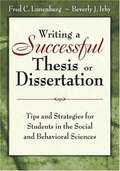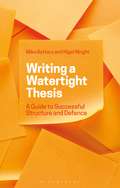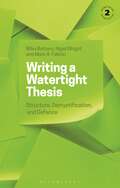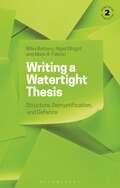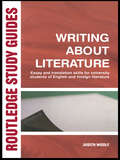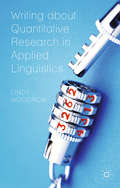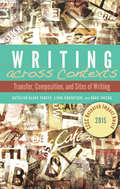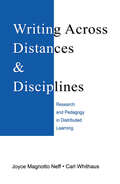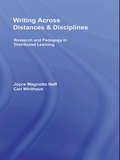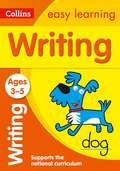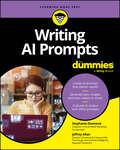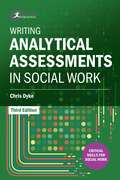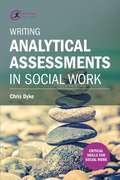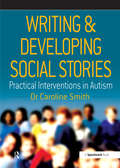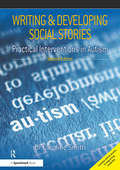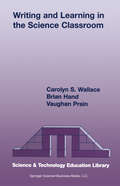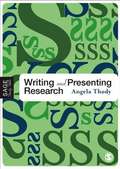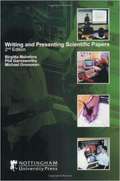- Table View
- List View
Writing a Successful Thesis or Dissertation: Tips and Strategies for Students in the Social and Behavioral Sciences
by Fred C. Lunenburg Beverly J. Irby"Accurate, clearly written, and easy to understand even for the beginning researcher, with equal coverage of both qualitative and quantitative research. This is the only book to combine a textbook approach with a how-to approach." -Carol Roberts, Professor, University of La Verne Author, The Dissertation Journey "This is a very practical book and will be immediately usable for graduate students at any stage in their research. The multitude of examples is wonderful, and the content is very current." -Mary Betsy Brenner, Professor of Education University of California, Santa Barbara The advice and resources you need to complete your thesis or dissertation! No matter what state or stage your project is in, this how-to manual provides comprehensive guidance to help you tackle your master′s thesis or doctoral dissertation. Covering both quantitative and qualitative research methods, this essential resource offers direction for every step of the process. Drawing on 40 years of experience supervising dissertations, the authors provide examples from 100 completed projects to guide readers through: Choosing a topic and writing research hypotheses Selecting a chair or committee Ensuring a successful proposal and oral defense Adapting the finished product for publication Using the Internet and desktop publishing effectively With a conversational style suitable for both faculty and students, Writing a Successful Thesis or Dissertation demystifies the writing experience and presents step-by-step directions for successfully completing your project.
Writing a Watertight Thesis: A Guide to Successful Structure and Defence
by Mike Bottery Nigel WrightWriting a doctoral thesis can be an arduous and confusing process. This book provides a clear framework for developing a sound structure for your thesis, using a simple approach to make it watertight, defensible and clear. Bottery and Wright draw on their extensive experience of supervising and examining numerous doctorates from an internationally diverse and multicultural student body both in the UK and overseas, and include examples of how successful theses have been made watertight along with exercises to enable readers to do the same thing to their own thesis. The authors demonstrate how the key to making a thesis watertight lies in selecting the central research question and the sub-research questions that together collectively answer this main one. If these questions are well formulated the thesis can be defended successfully against criticism on structural grounds – a major part of the battle. Including chapters on the viva process, strength-testing your thesis and essential preparation for writing up your research, this is the resource for anyone looking to produce a well-structured, watertight piece of research.
Writing a Watertight Thesis: A Guide to Successful Structure and Defence
by Mike Bottery Nigel WrightWriting a doctoral thesis can be an arduous and confusing process. This book provides a clear framework for developing a sound structure for your thesis, using a simple approach to make it watertight, defensible and clear. Bottery and Wright draw on their extensive experience of supervising and examining numerous doctorates from an internationally diverse and multicultural student body both in the UK and overseas, and include examples of how successful theses have been made watertight along with exercises to enable readers to do the same thing to their own thesis. The authors demonstrate how the key to making a thesis watertight lies in selecting the central research question and the sub-research questions that together collectively answer this main one. If these questions are well formulated the thesis can be defended successfully against criticism on structural grounds – a major part of the battle. Including chapters on the viva process, strength-testing your thesis and essential preparation for writing up your research, this is the resource for anyone looking to produce a well-structured, watertight piece of research.
Writing a Watertight Thesis: Structure, Demystification and Defence
by Mike Bottery Nigel Wright Mark A. FabriziWriting a doctoral thesis can be an arduous and confusing process. Writing a Watertight Thesis helps you to demystify many doctoral concerns and provides a clear framework for developing a sound structure for your thesis, making your thesis watertight, clear, and defensible. Now with the added experience of Mark A. Fabrizi, the authors draw on their extensive experience of supervising and examining numerous doctorates from an internationally diverse and multicultural student body around the world, including in Australia, Canada, China, Hong Kong, Saudi Arabia, the UK and the USA. The chapters on preparing a research proposal, the viva process, and developing publishable articles out of your thesis have all been updated, and new chapters have been added to demystifying common concerns:Do I have what it takes to do a doctorate?What is doctoral originality?Is my work of doctoral quality?What kind of relationship should I cultivate with my supervisor/advisors? Throughout the book you'll find examples showcasing central research questions and the sub-research questions derived from them, descriptions of different ways that doctoral students have achieved success, and exercises that will enable you to apply what you are reading directly to your own thesis.
Writing a Watertight Thesis: Structure, Demystification and Defence
by Mike Bottery Nigel Wright Mark A. FabriziWriting a doctoral thesis can be an arduous and confusing process. Writing a Watertight Thesis helps you to demystify many doctoral concerns and provides a clear framework for developing a sound structure for your thesis, making your thesis watertight, clear, and defensible. Now with the added experience of Mark A. Fabrizi, the authors draw on their extensive experience of supervising and examining numerous doctorates from an internationally diverse and multicultural student body around the world, including in Australia, Canada, China, Hong Kong, Saudi Arabia, the UK and the USA. The chapters on preparing a research proposal, the viva process, and developing publishable articles out of your thesis have all been updated, and new chapters have been added to demystifying common concerns:Do I have what it takes to do a doctorate?What is doctoral originality?Is my work of doctoral quality?What kind of relationship should I cultivate with my supervisor/advisors? Throughout the book you'll find examples showcasing central research questions and the sub-research questions derived from them, descriptions of different ways that doctoral students have achieved success, and exercises that will enable you to apply what you are reading directly to your own thesis.
Writing About Literature: Essay and Translation Skills for University Students of English and Foreign Literature
by Judith WoolfWriting about Literature combines detailed practical and scholarly advice with a sense of the scope and creative possibilities of literary criticism, empowering the student reader to make his or her own discoveries and experiments with language. In addition, it gives valuable guidance on adult language learning and translation skills for students of foreign literature. This handy, accessible guide covers all aspects of the essay-writing process, including: preliminary reading and choosing and researching a topic referencing and presentation computer use style, structure, vocabulary, grammar and spelling the art and craft of writing scholarly and personal insights into the problems and pleasures of writing about literature. Written in an entertaining and informative way and containing a wealth of practical advice and scholarly insights, this wise, witty and helpful book should be on every literature student's bookshelf.
Writing About Literature: Essay and Translation Skills for University Students of English and Foreign Literature
by Judith WoolfWriting about Literature combines detailed practical and scholarly advice with a sense of the scope and creative possibilities of literary criticism, empowering the student reader to make his or her own discoveries and experiments with language. In addition, it gives valuable guidance on adult language learning and translation skills for students of foreign literature. This handy, accessible guide covers all aspects of the essay-writing process, including: preliminary reading and choosing and researching a topic referencing and presentation computer use style, structure, vocabulary, grammar and spelling the art and craft of writing scholarly and personal insights into the problems and pleasures of writing about literature. Written in an entertaining and informative way and containing a wealth of practical advice and scholarly insights, this wise, witty and helpful book should be on every literature student's bookshelf.
Writing about Quantitative Research in Applied Linguistics
by L. WoodrowWith increasing pressure on academics and graduate students to publish in peer reviewed journals, this book offers a much-needed guide to writing about and publishing quantitative research in applied linguistics. With annotated examples and useful resources, this book will be indispensable to graduate students and seasoned researchers alike.
Writing across Contexts: Transfer, Composition, and Sites of Writing
by Kathleen Yancey Liane Robertson Kara TaczakAddressing how composers transfer both knowledge about and practices of writing, Writing across Contexts explores the grounding theory behind a specific composition curriculum called Teaching for Transfer (TFT) and analyzes the efficacy of the approach. Finding that TFT courses aid students in transfer in ways that other kinds of composition courses do not, the authors demonstrate that the content of this curriculum, including its reflective practice, provides a unique set of resources for students to call on and repurpose for new writing tasks. The authors provide a brief historical review, give attention to current curricular efforts designed to promote such transfer, and develop new insights into the role of prior knowledge in students' ability to transfer writing knowledge and practice, presenting three models of how students respond to and use new knowledge—assemblage, remix, and critical incident. A timely and significant contribution to the field, Writing across Contexts will be of interest to graduate students, composition scholars, WAC and writing-in-the-disciplines scholars, and writing program administrators.
Writing Across Distances and Disciplines: Research and Pedagogy in Distributed Learning
by Joyce Magnotto Neff Carl WhithausWriting Across Distances and Disciplines addresses questions that cross borders between onsite, hybrid, and distributed learning environments, between higher education and the workplace, and between distance education and composition pedagogy. This groundbreaking volume raises critical issues, clarifies key terms, reviews history and theory, analyzes current research, reconsiders pedagogy, explores specific applications of WAC and WID in distributed environments, and considers what business and education might teach one another about writing and learning. Exploring the intersection of writing across the curriculum, composition studies, and distance learning , it provides an in-depth look at issues of importance to students, faculty, and administrators regarding the technological future of writing and learning in higher education.
Writing Across Distances and Disciplines: Research and Pedagogy in Distributed Learning
by Joyce Magnotto Neff Carl WhithausWriting Across Distances and Disciplines addresses questions that cross borders between onsite, hybrid, and distributed learning environments, between higher education and the workplace, and between distance education and composition pedagogy. This groundbreaking volume raises critical issues, clarifies key terms, reviews history and theory, analyzes current research, reconsiders pedagogy, explores specific applications of WAC and WID in distributed environments, and considers what business and education might teach one another about writing and learning. Exploring the intersection of writing across the curriculum, composition studies, and distance learning , it provides an in-depth look at issues of importance to students, faculty, and administrators regarding the technological future of writing and learning in higher education.
Writing Ages 3-5: Ideal For Home Learning (Collins Easy Learning Preschool Ser.)
by Collins Easy LearningLearn the easy way with this writing activity book! Fully in line with the Early Years Foundation Stage, this English book provides reassurance whilst supporting your child's learning at home. Combining useful English practice with engaging, colourful illustrations, this Writing practice book helps to boost your child's confidence and develop good learning habits for life. Each fun activity is designed to give your child a real sense of achievement. Included in this book: questions that allow children to practise the important skills learned at school colourful activities that make learning fun and motivate children to learn at home helpful tips and answers so that you can support your child's learning
Writing AI Prompts For Dummies
by Stephanie Diamond Jeffrey AllanLearn the art of writing effective AI prompts and break into an exciting new career field Writing AI Prompts For Dummies gets you started on the path toward becoming an “AI psychologist” capable of getting all types of output from AI systems. This book walks you through the process of mining great results from leading platforms, so you can save time, solve problems, explore creative ideas, conduct research, and beyond. Even if you’re brand new to using AI chatbots, you’ll be able to follow the jargon-free explanations and instructions inside to learn how to ask questions and make requests in terms any AI can understand. Then, you can convert your new skill into greater productivity in your life, or even into a new career. Prompt engineering is a fast-growing career opportunity with six-figure salaries attached. Who knows? This Dummies guide could be your launchpad to a future as an AI whisperer. Explore the top AI chatbots, creativity engines, and productivity tools Learn how to write basic text prompts that generate concise, effective output Create AI-generated photos and illustrations that match your vision Save time writing code, designing websites, or conducting research When asked “Who needs to learn prompt engineering?” ChatGPT clarifies: professionals, creatives, educators, scientists, and entrepreneurs in many fields can benefit an enhanced ability to use AI productively. And for anyone working in AI, natural language processing, or related areas, Writing AI Prompts For Dummies is simply a must.
Writing AI Prompts For Dummies
by Stephanie Diamond Jeffrey AllanLearn the art of writing effective AI prompts and break into an exciting new career field Unlock the full power of generative AI with Writing AI Prompts For Dummies, a comprehensive guide that will teach you how to confidentially write effective AI prompts. Whether it's text, images, or even videos and music you're aiming to create, this book provides the foundational knowledge and practical strategies needed to produce impressive results. Embark on a journey of discovery with Writing AI Prompts For Dummies and learn how to: Craft AI prompts that produce the most powerful results. Navigate the complexities of different AI platforms with ease. Generate a diverse range of content, from compelling narratives to stunning visuals. Refine AI-generated output to perfection and integrate that output effectively into your business or project. This resource is brimming with expert guidance and will help you write AI prompts that achieve your objectives. Whether you're a marketer, educator, artist, or entrepreneur, Writing AI Prompts For Dummies is your indispensable guide for leveraging AI to its fullest potential. Get ready to harness the power of artificial intelligence and spark a revolution in your creative and professional efforts.
Writing Analytical Assessments In Social Work (2nd Edition) (PDF)
by Chris DykeWriting assessments and reports is a core part of a social worker's role. Yet Ofsted, courts and research all identify a lack of analytical rigour in social work reports. Many are overlong, descriptive reports where what is needs is the application of professional judgement, a clear analysis and the ability to pull out causal relationships. Writing Analytical Assessments in Social Work is a guide to the principles of good writing and methodically shows you: how to analyse how to structure the process of writing an assessment (researching, chronologising, informed data-gathering, putting it all together), and how to get this done under time constraints. Written in an accessible way and packed with examples and case studies, this book is both practically-minded and constantly returning to first principles: reminding you what it is you are trying to achieve and teaching you how to write reports that can be read by families and judges alike. You will learn how to write high quality, useful and timely assessments without becoming mechanistic or managerial. It aims to kill the myth of a trade-off between efficiency and quality of work.
Writing and Developing Social Stories
by Caroline SmithThis practical resource provides an introduction to the theory and practice of writing social stories. In addition, there are examples of successful stories to use as guides, as well as information and photocopiable resources for delivering training on the use of social stories. Based on detailed work carried out in homes, schools and pre-schools, this book offers practical support to anyone meeting the needs of a child or young adult with an autistic spectrum disorder. Social stories are short stories intended for children with autism to help them understand their social world and behave appropriately within it. The stories provide clear, concise and accurate information about what is happening in a specific situation, outlining both why it is happening and what a typical response might be. It is written by those directly supporting a child with autism and only successful stories are included in the book. The stories are infinitely flexible and adaptable to an individual child in an individual social situation. It covers children aged 3 to 16.
Writing and Developing Social Stories: Practical Interventions In Autism
by Caroline SmithThis practical resource provides an introduction to the theory and practice of writing social stories. In addition, there are examples of successful stories to use as guides, as well as information and photocopiable resources for delivering training on the use of social stories. Based on detailed work carried out in homes, schools and pre-schools, this book offers practical support to anyone meeting the needs of a child or young adult with an autistic spectrum disorder. Social stories are short stories intended for children with autism to help them understand their social world and behave appropriately within it. The stories provide clear, concise and accurate information about what is happening in a specific situation, outlining both why it is happening and what a typical response might be. It is written by those directly supporting a child with autism and only successful stories are included in the book. The stories are infinitely flexible and adaptable to an individual child in an individual social situation. It covers children aged 3 to 16.
Writing and Developing Social Stories Ed. 2: Practical Interventions in Autism
by Caroline SmithThis practical resource provides an introduction to the theory and practice of writing social stories. In addition, there are examples of successful stories to use as guides, as well as information and photocopiable (and downloadable) resources for delivering training on the use of social stories. Based on detailed work carried out in homes, schools and pre-schools, this book offers practical support to anyone meeting the needs of a child or young adult with an autistic spectrum disorder, and with staff supporting adults with autism. Social stories are short stories intended for children and adults with autism to help them understand their social world and behave appropriately within it. The stories: provide clear, concise and accurate information about what is happening in a specific situation, outlining both why it is happening and what a typical response might be; are written by those directly supporting children or adults with autism and only successful stories are included in the book; are infinitely flexible and adaptable to an individual child in an individual social situation. FEATURES: This 2nd edition has been thoroughly revised and updated throughout. It also now contains: brand new stories including examples for use by parents at home; brand new section on mental health; and, additional stories for use with adults with autism.
Writing and Developing Social Stories Ed. 2: Practical Interventions in Autism
by Caroline SmithThis practical resource provides an introduction to the theory and practice of writing social stories. In addition, there are examples of successful stories to use as guides, as well as information and photocopiable (and downloadable) resources for delivering training on the use of social stories. Based on detailed work carried out in homes, schools and pre-schools, this book offers practical support to anyone meeting the needs of a child or young adult with an autistic spectrum disorder, and with staff supporting adults with autism. Social stories are short stories intended for children and adults with autism to help them understand their social world and behave appropriately within it. The stories: provide clear, concise and accurate information about what is happening in a specific situation, outlining both why it is happening and what a typical response might be; are written by those directly supporting children or adults with autism and only successful stories are included in the book; are infinitely flexible and adaptable to an individual child in an individual social situation. FEATURES: This 2nd edition has been thoroughly revised and updated throughout. It also now contains: brand new stories including examples for use by parents at home; brand new section on mental health; and, additional stories for use with adults with autism.
Writing and Learning in the Science Classroom (Contemporary Trends and Issues in Science Education #23)
by Carolyn S. Wallace Brian B. Hand Vaughan PrainThis volume is of interest to science educators, graduate students, and classroom teachers. The book will also be an important addition to any scholarly library focusing on science education, science literacy, and writing. This book is unique in that it synthesizes the research of the three leading researchers in the field of writing to learn science: Carolyn S. Wallace, Brian Hand, and Vaughan Prain. It includes a comprehensive review of salient literature in the field, detailed reports of the authors' own research studies, and current and future issues on writing in science. The book is the first to definitely answer the question, "Does writing improve science learning?". Further, it provides evidence for some of the mechanisms through which learning occurs. It combines both theory and practice in a unique way. Although primarily a tool for research, classroom teachers will also find many practical suggestions for using writing in the science classroom.
Writing and Presenting Research (PDF)
by Angela ThodyThis accessible and wide-ranging book is an invaluable introductory guide through the choices to be made when deciding how to report research. Writing and Presenting Research covers research written as theses and dissertations; chapters, books, reports and articles in academic, professional or general media such as newspapers; and also reviews the options for presenting research orally as lectures, keynotes, conference papers and even TV game shows. These forms of reporting research have well-established conventions for their formats, but they also have growing numbers of alternative possibilities. This has generated debate about what is, or is not, acceptable, and the aim of this book is to make this debate more manageable for those wanting to assess which of the conventional or alternative possibilities on offer is most appropriate for reporting their current research. Arranged in easily followed sections enlivened with checklists, style variations, examples and reflection points, Writing and Presenting Research has relevance to the social sciences, arts, humanities, natural and applied sciences and law and is an invaluable reference tool for new and experienced researchers alike. SAGE Study Skills are essential study guides for students of all levels. From how to write great essays and succeeding at university, to writing your undergraduate dissertation and doing postgraduate research, SAGE Study Skills help you get the best from your time at university. Visit the SAGE Study Skills website for tips, quizzes and videos on study success!
Writing and Presenting Scientific Papers: 2nd edition
by B MalmforsThe aim of this book is to provide guidelines for preparing papers and presentations so that your message can be transmitted clearly and concisely to the reader or listener. Techniques for improving your writing, literature searching and training students in communication are also discussed.
Writing and Publishing in Architecture and Design
by Anne MasseyThis book outlines the process of writing and publishing research in the field of architecture and design. The book sets out to help researchers find a voice and find the best fit for their work. Information about the different types of publication on offer is set out, as well as how to make that important initial approach. From pitching an idea for a review in a magazine, to producing a journal article right through to the monograph, Writing and Publishing in Architecture and Design maps out the different steps for the novice author. Your first steps in publishing can be daunting, and the book offers material which will inspire confidence, by demystifying the publication process. It also includes valuable nuts and bolts material such as planning and structure, time management, writing styles, editing, production of the final manuscript and picture research. How do you turn your PhD into a book? How do you turn conference proceedings into a publication? Commissioning editors and authors share their experiences through interview and offer recipes for success as well as what to avoid. Key titles from the past are included as case studies, and their pathway to publication explored. This is an invaluable book for anyone working in the fields of architecture and design, with an ambition to publish.
Writing and Publishing in Architecture and Design
by Anne MasseyThis book outlines the process of writing and publishing research in the field of architecture and design. The book sets out to help researchers find a voice and find the best fit for their work. Information about the different types of publication on offer is set out, as well as how to make that important initial approach. From pitching an idea for a review in a magazine, to producing a journal article right through to the monograph, Writing and Publishing in Architecture and Design maps out the different steps for the novice author. Your first steps in publishing can be daunting, and the book offers material which will inspire confidence, by demystifying the publication process. It also includes valuable nuts and bolts material such as planning and structure, time management, writing styles, editing, production of the final manuscript and picture research. How do you turn your PhD into a book? How do you turn conference proceedings into a publication? Commissioning editors and authors share their experiences through interview and offer recipes for success as well as what to avoid. Key titles from the past are included as case studies, and their pathway to publication explored. This is an invaluable book for anyone working in the fields of architecture and design, with an ambition to publish.
